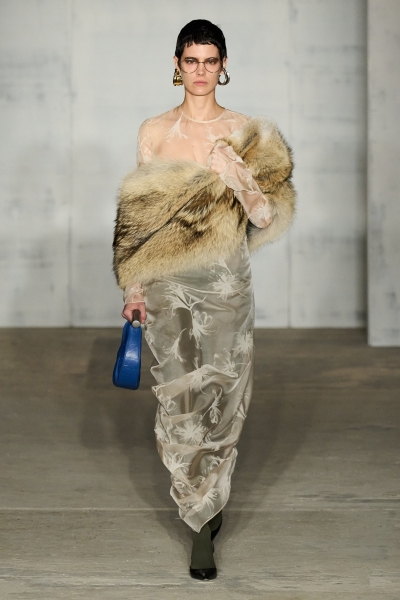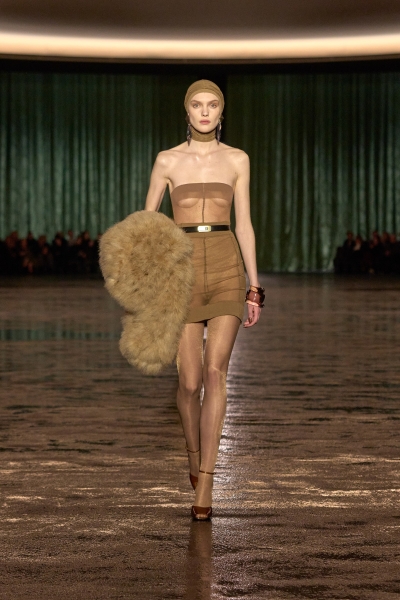
At first, it just felt like a TikTok trend: Gen Z and millennials wearing vintage fur or faux-fur coats to incarnate the so-called mob-wife aesthetic—an ostentatious mafioso style that takes cues from Carmela Soprano and The Godfather’s Connie Corleone. Then it felt like a celebrity stunt moment: Kendall Jenner and Hailey Bieber wearing shearling coats in Aspen, Ice Spice wearing repurposed fur to the 2024 Grammys, and Kim Kardashian stepping out in a matching fuzzy Prada set—all within a few months of each other. But suddenly it felt like a real thing. The bellwether perhaps began with Pharrell Williams’s Louis Vuitton men’s collections and their floor length dusters. It continued during New York Fashion Week, where models wearing fur—some of it real, some vintage, some faux—strutted down several runways. Luar had fur stoles, and LaQuan Smith opted for opulent bomber jackets. Models in bold, burgundy shearling jackets strutted at Khaite, while over in London Simone Rocha wrapped her models’ shoulders in faux-fur patches. Fast-forward to Milan, and Bally showed dresses and vests lined with elegant fur trimmings. Before Paris even began—where Miu Miu put a faux fur coat on Gigi Hadid and Balenciaga opted for faux-fur dusters—it was clear. The fur aesthetic had officially gone far beyond algorithms. “It’s still minimal in its nature, but it’s maximal in a way that it takes up a lot of space,” a luxury retail executive tells Vogue of fur’s trending status. “There’s confidence. We’re pushing out of that quiet luxury to the next level.” (This source, like several others Vogue reached out to, did not want to go on record about the controversial material.)

Faux fur and even shearling—which is the skin of a sheep or lamb that has been shorn once shortly before slaughter for meat—is one thing. But the return of real fur has taken many in the industry by surprise. In 2021, it appeared to be firmly out. Kering—the French luxury conglomerate that owns Gucci, Saint Laurent, Bottega Veneta, and Balenciaga, among many other labels—banned its use across its maisons. Billie Eilish asked Oscar de la Renta to go fur-free, and it agreed. Saks Fifth Avenue closed their fur salons and announced they’d stop selling fur goods by 2023. Meanwhile, California banned the sale of mink, sable, chinchilla, lynx, fox, rabbit, beaver, and coyote furs outright. The British Fashion Council even banned it from London Fashion Week.
But here’s the thing: Even though real fur became a material non grata, the glamorous image it bestowed on its wearer, well, didn’t. Fur, for millennia, has been a style marker of social status: High priests in Egypt wore the skins of leopards, and wealthy Vikings draped themselves in beaver pelts. In England, only royalty could wear ermine during the reign of Edward III. (To this day, British kings and queens still wear ermine-lined robes for their coronations.) In the 17th century, beavers almost went extinct due to the popularity of beaver-fur felt hats—and, in the process, John Jacob Astor’s fur-trading monopoly led to a fortune that forever changed the city of New York. The mink coat was worn by well-to-do New York women from the late 19th century onward: Elizabeth Taylor won an Oscar for her role in BUtterfield 8, in which she plays a Manhattan call girl who falls in love with a married man and steals his wife’s mink coat. It’s hard for humanity to suddenly not long for an object that they’ve been wired to desire for thousands of years. Indeed, to some women in the Black community, as reported by the New York Times, owning a well-made coat is not just a status symbol but one of hard-earned economic prowess. “Fur will always have a luxury aura about it,” designer Bach Mai tells Vogue. “There is a desire for it.”
Mai doesn’t currently design with real fur. However, the Parsons and Institut Français de la Mode graduate is a trained furrier—meaning he has the technical skill to sew and make clothing from animal skins. Many of the luxury houses that do use fur, he points out, work with companies like Saga Fur that offer traceability programs via Furmark, enabling manufacturers to trace the origin of their pelts down to individual farms. (LVMH also has a 16-page animal-based raw-materials-sourcing charter.) But Mai notes that fur clothing is a byproduct of an era where clothes were customized or made to order. “These were such investment pieces and heirloom items,” he says. “It was slow fashion—the idea to invest in things that are meant to last and that people put a lot of time and care into. It’s not meant to be discarded.”
When fur is used in a slow-fashion way, it is a relatively sustainable resource. It’s in the farmer’s best interest to maximize every part of the animal: The cows we eat are also used for leather. Shearling comes from lambs set to be consumed, making it a byproduct of our food supply. (This is why shearling is often still sold by retailers that have banned most other types of fur—and is not included in the statewide or company-wide bans.) For those animals we don’t eat, the meat often goes into animal feed, fertilizers, or other various products. Mink fat, for example, can be used in soap manufacturing.

But we don’t live in a world of slow fashion anymore. We live in a fast, mass-consumer one. And in that world, more than one billion animals are killed every year for the fur industry, according to the Journal of Animal Ethics. Ethically, it’s hard for some to justify that number. And sure, some luxury brands have enough money to use high-end fur companies that offer transparency and traceability, but that’s more often the exception than the rule. There’s no way that all those animals are killed responsibly or handled sustainability (if you even think either is possible).
The solution, at first, seemed like faux fur: something that made the wearer feel luxurious yet was cruelty-free. Yet faux fur is most often made from microplastics, which are not biodegradable. According to the United Nations, synthetic clothing releases an estimated 1.4 million trillion plastic fibers per year into the ocean. This seemingly leaves consumers with no great choice: Eco-friendliness comes at the price of ethics, or ethics comes at the price of eco-friendliness. “Fur can be sustainable, but faux fur is not,” Mai says. “But faux fur isn’t an animal product, and fur is. Those are two separate conversations.”
Many consumers and designers recognized this and sought a different, environmentally friendly embrace of the material. Enter vintage fur. It circumvents both the problems of real fur and faux fur; you are neither harming any animals nor creating any waste for landfills. For example, brands like Nereja are making modern coats out of found and thrifted materials. “With upcycling and vintage, you’re not causing any additional harm,” the designers told Vogue in 2021. Meanwhile, interest in thrifting has reached an all-time high. Some 62% of Gen Z and millennial consumers say they look for items secondhand before buying new. (“Clean girl is out, mob-wife era is in…. We’re wearing vintage furs all winter,” TikToker Kayla Trivieri said in her now viral voiceover describing the mob-wife aesthetic.)
The only problem? Optics. It’s impossible to know what is upcycled fur versus newly harvested fur. Many feel like they’re still stuck in a moral quandary. The aforementioned fashion executive recalls to Vogue overhearing a front-row guest wearing fur readily declare its conflict-free status: “Everyone’s so studied in how they’re going to explain that they’ve gone back to wearing fur, justifying it by saying, ‘It’s in my closet anyways, it’s vintage, and I might as well wear it.’”
In a way, the very act of wearing fur—especially when done by high-fashion brands and celebrities—feels like a promotion. People don’t know how you sourced the material. But they do know it continues to be coveted. “As a designer, you come with a set of responsibilities,” says Hillary Taymour, the designer of Collina Strada. “When you put a model down the runway, you are saying, ‘This is what I believe in, and I think these are cool. This is what’s popular. This is what the trend is. This is what the future of fashion looks like to me as a designer.’ The more famous you are, the more reach you have. You have a responsibility as a designer to create things that aren’t going to trickle down in a wasteful manner or a politically incorrect manner.” Previously, Taymour has used deadstock faux fur in her collections—a sustainable, cruelty-free choice. However, she stopped even that in 2018.
There is a possible solution to this hotly debated fashion quandary on the horizon. In 2022, LVMH—the world’s largest luxury fashion conglomerate, which still allows its houses to use fur—announced a partnership with Imperial College London and Central Saint Martins University of the Arts to develop lab-grown fur fibers. “The ultimate goal at LVMH is to have these alternative innovative materials but not using plastics,” environment development deputy director Alexandre Capelli told Vogue Business. “Even if the quality of fake fur has improved in the last year, it’s still not at the level of natural fur. We think that with this innovation, we should be able to achieve this level of quality—very close to natural fur.” Still, it’s unclear if this material will ever, well, materialize. Proof of concept is expected sometime in 2024. Other designers are getting creative: Gabriela Hearst sent fur-looking coats down the runway that were actually sheared, woven cashmere. Anthony Vaccarello, meanwhile, at Yves Saint Laurent experimented with powder-puff marabou jackets. (Marabou is a type of feather that can easily mimic the texture of fur.) Even The Row—the trailblazers of minimalistic stealth wealth—used shaggy wool for their most recent collection. Meanwhile, shearling is still widely embraced as a more-moral material.

As for now, one big question looms: Will real fur sell? According to The Business of Fashion, when Gucci banned fur in 2017, the material accounted for around 10 million euros in sales—only 0.2% of the label’s annual revenue. The same year, e-commerce giant Net-a-Porter pulled furs from its website after more than half of customers said they wanted the retailer to stop selling it. The choice, it seems, is the consumers’.

